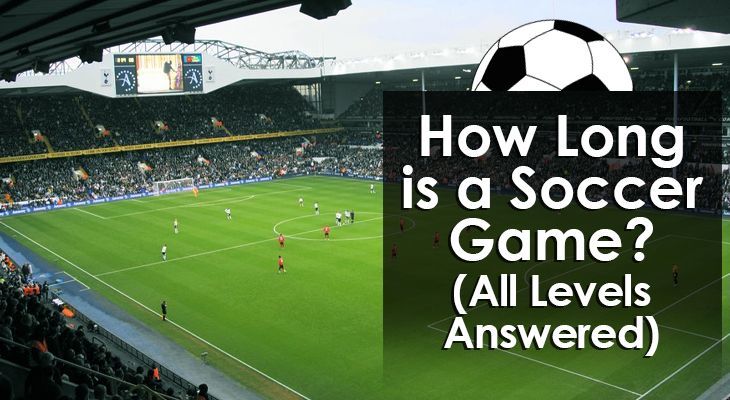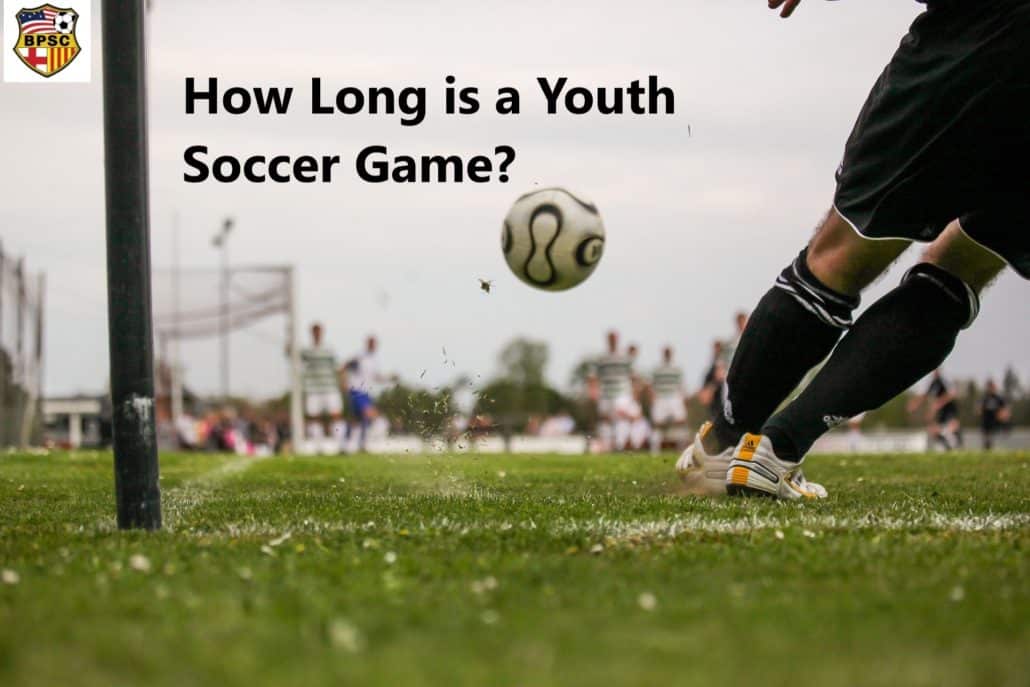How Long are Soccer Games? Soccer games typically last around 90 minutes, including stoppage time.
The Duration Of A Soccer Match
Soccer, known as football in many parts of the world, is a thrilling sport that captivates fans with its fast pace and skillful plays. Understanding the duration of a soccer match is essential for both players and fans, as it dictates the flow and intensity of the game. Let’s delve into the specifics of how long a soccer game lasts, from regulation time to injury time and stoppage.
Regulation Time
How Long are Soccer Games? Regulation time in a soccer match consists of two halves, each lasting 45 minutes. After the first half, the teams typically take a 15-minute break before resuming play. This brings the total regulation time to 90 minutes, during which the clock runs continuously, except for stoppages for injuries or other significant delays.
Injury Time And Stoppage
Injury time, also known as stoppage time, is added to the end of each half to compensate for time lost due to injuries, substitutions, and other interruptions. The referee determines the amount of injury time based on the stoppages that occurred during the half. This additional time ensures that the full 45 minutes of play are completed, even if there were delays during the half.
Halftime Intervals And Breaks
Soccer games consist of two halves, each lasting 45 minutes, with a 15-minute halftime break in between. The total duration of a standard soccer match is typically 90 minutes. This interval allows players to rest, strategize, and recharge for the second half.
Soccer games are known for their fast-paced, high-energy action that keeps fans on the edge of their seats. However, even the fittest athletes need a break to catch their breath and regroup. That’s where halftime intervals and breaks come in.
Standard Halftime Length
During a standard soccer game, halftime is typically around 15 minutes long. This allows players to rest, rehydrate, and receive any necessary medical attention. Coaches also use this time to make adjustments to their strategies and motivate their players. Fans can use this time to grab some refreshments or check out the merchandise stands.
Extended Breaks For Special Matches
In some special matches, such as championship games or international tournaments, halftime may be extended to 20 minutes or more. This gives players more time to rest and recover, as these matches can be particularly grueling and intense. It also gives fans more time to socialize and enjoy the atmosphere of the event. In conclusion, halftime intervals and breaks are an essential part of soccer games. They provide players with the rest they need to perform at their best, coaches with the opportunity to strategize, and fans with a chance to take a breather and enjoy the game.
Extra Time In Knockout Stages
Soccer games typically last for 90 minutes, divided into two halves of 45 minutes each. In knockout stages, if the score is tied at the end of regulation time, an additional 30 minutes of extra time is played.
Structure Of Extra Time
In knockout stages, extra time consists of two 15-minute halves.
Impact On Player Performance
Extra time can lead to fatigue and affect player performance. In the knockout stages of a soccer tournament, when a match ends in a draw after the regular 90 minutes, extra time is played to determine the winner. The structure of extra time involves two 15-minute halves, providing an additional opportunity for teams to score and secure victory.
However, the prolonged duration of the game can have a significant impact on player performance. The physical and mental strain of playing extra time can lead to fatigue among players. This exhaustion may result in a decline in speed, agility, and decision-making, affecting the overall performance on the field. As the match progresses, the players’ endurance and focus are put to the test, with the potential for injuries also increasing due to the extended gameplay.
Teams must carefully manage their substitutions and tactical strategies during extra time to maintain the competitiveness and effectiveness of their squad. The outcome of a match in the knockout stages can often be determined by which team copes better with the demands of extra time, showcasing the mental toughness and physical preparedness of the players.

Credit: www.soccercoachingpro.com
The Role Of Penalty Shootouts
Penalty shootouts play a crucial role in deciding the winner of soccer games when the regular playing time and extra time end in a draw. These nail-biting moments often determine the fate of teams, adding excitement and drama to the sport.
Deciding Tied Games
In the world of soccer, matches can often end in a tie when the allotted time runs out. This leaves the question of how to determine a winner when the score is level. That’s where penalty shootouts come into play. Penalty shootouts are an intense and nail-biting way to settle tied games, adding an extra layer of excitement to the sport. Let’s delve into the role of penalty shootouts in deciding tied soccer games.
Psychological Dynamics
Penalty shootouts not only test the physical skills of the players but also their mental strength and composure. These high-pressure situations can be incredibly challenging for both the shooters and the goalkeepers. The psychological dynamics at play during penalty shootouts are fascinating to observe. The pressure to perform and the weight of expectations can often lead to unexpected outcomes. It’s not uncommon to see even the most skilled players miss their shots or goalkeepers make incredible saves. The mental fortitude and ability to handle the pressure become crucial factors in determining the outcome of a penalty shootout.
Table: Penalty Shootout Statistics
To give you a better understanding of the significance of penalty shootouts, here are some intriguing statistics:
| Competition | Success Rate | Most Successful Team |
|---|---|---|
| FIFA World Cup | 70% | Germany |
| UEFA Champions League | 74% | Real Madrid |
| English Premier League | 72% | Manchester United |
These statistics highlight the importance of penalty shootouts in determining winners in various prestigious competitions. Teams with a higher success rate in penalty shootouts often have an edge in achieving victory. Penalty shootouts are an integral part of soccer, providing thrilling moments and adding an element of unpredictability to the game. They test the skills and mental resilience of the players, making them a captivating spectacle for fans worldwide. So, the next time you watch a soccer match that goes into extra time and ends in a tie, brace yourself for the excitement and tension of a penalty shootout.
Referee’s Discretion On Timekeeping
Soccer games are known for their unpredictable nature, and one aspect that adds to this unpredictability is the referee’s discretion on timekeeping. The amount of time added at the end of each half, known as stoppage time, is determined by the referee based on various factors.
Influences On Stoppage Time
Several factors can influence the amount of stoppage time added by the referee. These factors include injuries, substitutions, time-wasting tactics, and other unforeseen interruptions during the game.
Controversies And Discussions
The allocation of stoppage time often sparks controversy and heated discussions among players, coaches, and fans. Disagreements over the amount of time added can lead to tense moments on the field and prolonged debates off the pitch.

Credit: jobsinfootball.com
Variations In Youth And Amateur Leagues
When it comes to soccer games, the duration can vary depending on the level of play. This is particularly true in youth and amateur leagues, where match lengths differ from the standard game duration. Understanding these variations is essential for players, coaches, and spectators alike. Let’s explore the differences in match length and the reasons behind these variations.
Differences In Match Length
In youth soccer leagues, matches are typically shorter compared to professional games. The duration varies based on age groups, ensuring that younger players have age-appropriate game times. Here is a breakdown of the average match lengths for different youth age groups:
| Age Group | Match Length |
|---|---|
| Under 6 | 10-20 minutes |
| Under 8 | 20-30 minutes |
| Under 10 | 30-40 minutes |
| Under 12 | 40-50 minutes |
As players get older, the match lengths gradually increase, allowing for a more challenging and competitive game experience. It’s important for parents and coaches to be aware of these variations to ensure that young players are not overwhelmed by longer game durations.
Reasons For Variation
Several factors contribute to the variation in match lengths across youth and amateur leagues. Here are some common reasons:
- Physical endurance: Younger players may have limited stamina compared to older players, necessitating shorter game times to prevent fatigue.
- Developmental needs: Younger age groups require more breaks and rest periods to accommodate their physical and cognitive development.
- Skill progression: As players grow older, they develop more advanced skills and strategies. Longer match lengths allow for more opportunities to showcase these abilities.
- Time constraints: Amateur leagues often have limited time slots for matches, making it necessary to adjust game durations to fit within the allocated time frame.
Understanding the reasons behind these variations helps create a better playing experience for young athletes. It ensures that games are both challenging and enjoyable, promoting skill development and fostering a love for the sport.
Impact Of Broadcast And Commercial Breaks
Soccer games typically last around 90 minutes, divided into two halves of 45 minutes each. The actual time can vary due to stoppages for injuries, substitutions, and added time. Broadcast and commercial breaks during halftime and stoppages can extend the overall duration of the game.
Television Schedules’ Influence
In the fast-paced world of soccer, television schedules significantly impact game durations. Networks strategically plan broadcasts around commercial breaks.
Adjustments For Major Tournaments
During major tournaments, such as the World Cup, soccer games may include additional time for commercials and analysis.
Soccer Time Regulations Around The World
Comparing Different Leagues
Each league has varying game lengths.
- Premier League: 90 minutes
- La Liga: 90 minutes
- Bundesliga: 90 minutes
Cultural Influences On Game Duration
Cultural factors impact soccer game time.
- Latin American leagues may have added time.
- Asian leagues tend to stick to strict game durations.

Credit: barcelonapremiersc.com
Frequently Asked Questions
How Long Does A Soccer Game Last?
A standard soccer game lasts for 90 minutes, divided into two 45-minute halves. However, the actual duration can be longer due to stoppage time, which is added for delays during the game.
What Is The Duration Of Halftime In Soccer?
The halftime break in a soccer game typically lasts for 15 minutes. This allows the players to rest, rehydrate, and receive instructions from their coaches before resuming the second half.
Why Do Soccer Games Have Added Time?
Added time, also known as stoppage time, is given at the end of each half to compensate for time lost due to injuries, substitutions, and other game delays. It ensures that the full amount of playing time is completed.
Conclusion
To sum up, soccer games typically last for 90 minutes, divided into two 45-minute halves. However, stoppage time may be added at the discretion of the referee to account for any time lost due to injuries or other interruptions during the game.
Understanding the length of a soccer game is important for both players and fans, as it allows them to better plan and enjoy the game. So, whether you’re a seasoned soccer player or a newbie fan, knowing the duration of the game is a crucial element to fully appreciate the beauty of this sport.